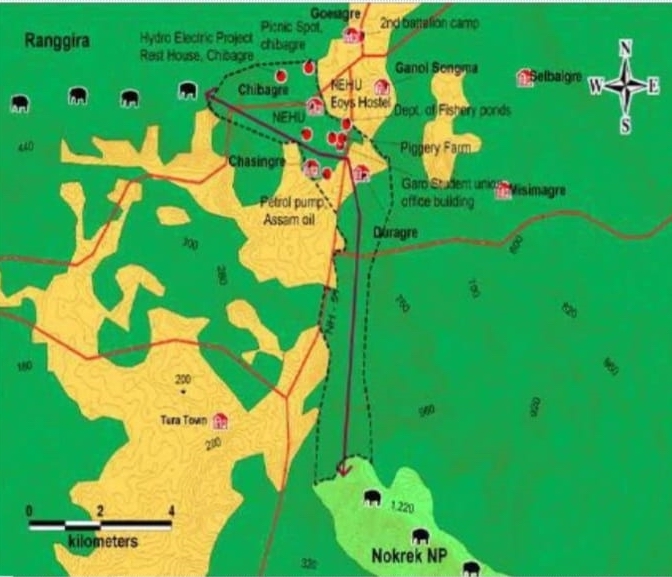By Roopak Goswami
Guwahati, Sept 11: Hemmed in from all sides by linear infrastructure and human interference, the Ranggira Nokrek elephant corridor in Meghalaya stands impaired.
The eight-long elephant corridor connects Ranggira, Sanchonggre and Galwang Reserved Forest to Nokrek National Park and is very critical for the movement of elephants and other wildlife from Ranggira to Nokrek National Park.
Wildlife corridors can be envisioned as strips of habitat or movement pathways that connect otherwise disconnected habitat patches. Wildlife corridors facilitate animal movement between habitat patches, and in the process maintain the long-term demographic and genetic viability of elephant populations.
Consider this what comes in the way of Ranggira Nokrek elephant corridor – National Highway-51 and Asanang Williamnagar Road, Tura campus of NEHU, Garo Student Union building and second Meghalaya Reserved Police battalion. There are plantations and human settlements too.
” There is no alternative now as there is a lot of linear infrastructure and other interference from all sides. It’s tough now to restore the corridor” a senior state forest department official told TME.
” We had discussed this with NEHU authorities but no solution came out” the official said.
According to the 2017 elephant census, Meghalaya has 1754 elephants. There are five elephant corridors- Siju – Rewak (Length-1.6 km, Width-0.5 Km) , Baghmara – Balpakram (Length-6 km, Width-4.5 Kms), Rewak – Imangiri (Length-6.5-8.4 Kms, Width-1.7-2.8 Kms), Rangira – Nokrek (Length-7-8 Kms, Width-0.1-1.5 Kms) and Imangiri – Nokrek (Length-4-5 Kms, Width-3-4 Kms).
About 40-50 elephants used to go through this corridor, but not any more now.
“In the past, elephants from the Western Garo Hills and Bangladesh, particularly from the Ranggira Range, could move freely to the Nokrek Biosphere Reserve without clashing with humans. This was due to people’s deep understanding of the elephant corridors and their decision to avoid occupying these migratory routes. Even when elephants destroyed crops, villagers respected their paths, guiding the animals safely away from their homes to avoid conflict. This peaceful coexistence persisted as long as the corridors were preserved” Pakseng À Sangma HURO India president said.
Pakseng was born and raised in Garo Hills and knows the area well. HURO India works for Western Hoolock Gibbons in Meghalaya.
Sangma said in the 1980s, this harmony was disrupted when the headman of Chibragre granted land for the establishment of the 2nd Meghalaya Reserved Battalion. Despite the area being a known elephant breeding ground, the headman allocated the land, and elephants continued to use the corridor between Ganolgre and Rongram, especially after dusk. “Over time, however, encroachment by the battalion’s staff families and local villagers, who built homes and shops along the corridor, slowly led to the elephant route’s permanent disappearance,” he said.
“With their original route blocked, elephants began using a new corridor in the Chasingre A’kingland Private Reserved Forest, which has since become the NEHU campus. Though the area was a thriving habitat for wildlife, development again took priority as the land was given to establish the university. This cut off the elephants’ access to the Nokrek Biosphere Reserve from the Ranggira Range, leaving no viable corridor for their movement” he added.
The 2023 Elephant Corridors report brought out by Wildlife Institute said the state forest department had made certain recommendations to improve the corridor- the department should secure land on the other side of the road to the NEHU campus to provide 500 metres width to the corridor, legal protection of the corridor area, negotiation with NEHU authorities to spare about 44 hectares of land near the hostel area for elephant movement and the Garo student union building( now school) has to be relocated to alternate side outside the corridor. “Securing elephant corridors remains a central strategy for elephant conservation in the country,” the report had said.
A forest official said the situation remains the same as it was earlier.
As more human activities inch closer to critical wildlife zones, the future of the Rangira-Nokrek elephant corridor—and the wildlife that depends on it—remains uncertain.




